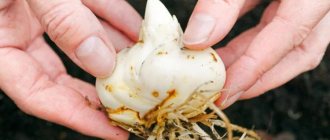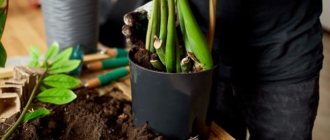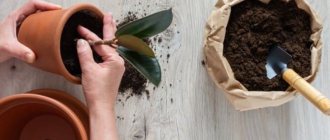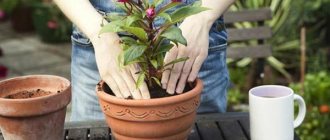Why is it better to wait for a period of rest?
It is better to replant the plant after flowering, when the dormant period begins, so as not to harm this magnificent plant. An orchid should be replanted no more than once every 2-3 years. It is worth understanding that replanting causes stress to any plant, and even more so to a delicate orchid.
The best time to replant the plant after flowering is spring. At this time of year, nature begins to wake up, and it will be easier for the orchid to grow new roots and recover from stress.
As for the children, it is better to plant them in late autumn or winter.
The timing of replanting directly depends on whether the orchid belongs to a particular variety - but spring is the optimal time of year for almost everyone. For example, there are plant species such as cattleya, oncidium and dendrobium that need to be replanted only when the first cuttings appear, but before the baby takes root. And monopodial orchids are replanted as soon as the tips of the roots turn bright green. We talked about the possibility of replanting an orchid in the fall here.
There are many reasons for untimely transplantation of an orchid after flowering, but nevertheless, when making such a decision, you need to think carefully.
Do I need to replant my orchid?
A home orchid is replanted to provide the plant with the most comfortable conditions that are important for healthy growth , and sometimes in order to save the pet. During the procedure:
- replace the compacted or decaying depleted substrate with a fresh one;
- carry out an audit of the root system, remove rotten, damaged, dried roots;
- change and disinfect drainage;
- if necessary, treat the plant against pests and diseases;
- move the orchid to a larger or, conversely, cramped pot.
On average, orchids are replanted every 2-3 years . It is believed that this is how long the substrate “lives.”
Planned transplantation of a healthy plant is carried out in several cases.
Roots are cramped in an old pot
As a rule, species native to the tropics and subtropics are grown at home. Most of them are epiphytes and lithophytes. Roots play a huge, decisive role in the life of these plants. Therefore, the condition of the root system of orchids is monitored especially closely , special conditions are created, because the life of a whimsical exotic depends on their health.
Excessive growth of healthy orchid roots is an indication for transplantation. In this case, they are insufficiently aerated, illuminated, and do not have the opportunity to grow and develop freely.
If the roots grow excessively, the orchid is replanted.
“Aging” and soil depletion
Over time, the substrate in which orchids live becomes compacted due to decomposition into a fine-grained fraction. It becomes airtight, does not accumulate nutrients, and becomes contaminated with compounds found in tap water. Dense soil dries unevenly, causing moisture to stagnate at the roots.
Pathogenic microorganisms can provoke putrefactive processes in the substrate and the development of diseases.
Advice! Experienced gardeners believe that a sphagnum-based substrate retains its vital properties for two years, while the bark “lasts” about a year longer. After this period, it is useful to replant a healthy plant.
Mass formation of aerial roots
The abundance and active growth of aerial roots indicates that the plant lacks nutrients or moisture and is trying to make up for the deficiency from the air. Perhaps the problem is poor soil condition or root problems.
Yellow or pale spots on leaves
Spots on the leaf blades of a generally healthy specimen may indicate:
- presence of pests;
- the beginning of the development of the disease;
- errors in care.
When replanting, you should take time to carefully examine all parts of the plant. Overwatering and improper lighting can also be the cause of various types of stains.
Lots of foliage
The growth of green mass most often occurs on nitrogen-rich soils and in containers larger than required. The roots of the orchid should not be too spacious.
No flowering for more than 3 months
This problem is often caused by a lack of air and moisture at the roots and leaves. A fresh, breathable, properly moistened substrate will help.
If there is no flowering for a long time, replacing the substrate will help.
When can a plant change its soil?
As mentioned earlier, after flowering, the flower is replanted in the spring . But how can a beginner determine that it’s time for an orchid to change the soil? There is a theory that the plant should not be touched for 2 years, and only after that is it ready for replanting. But you shouldn’t trust the standards unconditionally, since they are not the same for different species. There are practical examples by which you can accurately determine the time of transplantation:
- a powerful root system that has become cramped in the old pot;
- a large number of aerial roots are formed;
- the leaves began to become covered with pale green or yellow spots;
- the orchid does not produce a peduncle for more than three months from the moment of the last flowering;
- the volume of green mass is several times greater than the size of the pot.
But there are parameters that force the grower to transplant ahead of time.
Preparing the pot and soil
Any movement is stressful for the plant, even simply moving the pot from place to place. And the transplant - even more so. Before transplantation find:
- landing container of the required size;
- suitable substrate.
The pot is mainly chosen:
- transparent, because orchid roots are able to receive moisture and nutrition from the air;
- it must have drainage holes to remove excess moisture;
- its dimensions do not exceed the size of the previous one by more than 0.5 liters, otherwise you may not be able to wait for the sight of blooming orchids. They will build up leaf mass.
The soil for replanting an orchid is changed in several cases:
- when it lacks nutrients;
- its acidity has increased;
- the substrate began to decompose;
- compacted and became airtight;
- mineral salts accumulate in it as a result of improper watering.
It must meet several criteria:
- be water- and breathable;
- loose;
- light;
- have a neutral pH;
- be environmentally friendly.
The substrate for the flower is made up of moss, charcoal and bark, and over time it swells and collapses from moisture. When harvesting yourself, the bark is crushed to 2-3 cm, boiled for 30 minutes and sorted into large and small. Moss is collected from lowlands and soaked for several hours.
On a note!
The substrate for this flower initially serves as a support, and then as a source of nutrition, so it does not require a base that includes soil.
Why might it be necessary to transplant into another pot?
An urgent plant transplant may be needed in the following cases:
- rotting of the lower leaves and roots;
- the appearance of pests on the plant;
- depleted and excessively dry substrate;
- pale leaves, stunted growth, exposed roots;
- plant instability.
Attention! Water with a high content of heavy impurities and iron can accelerate the process of rotting of the substrate.
If the plant feels good in the old pot, then there is no need to touch it . But if the roots turn black, mold appears on the rosette, or microorganisms appear, then the flower is in great danger.
Read more about whether the orchid needs to be transplanted into another pot here.
Transfer
Before planting, a drainage layer is poured onto the bottom of the container, which is washed, disinfected and dried before use. Clay shards, broken red bricks and small pebbles are used for drainage. The height of the drainage layer does not exceed 1/5 of the height of the pot. Then the container is filled 1/3 with the substrate, the orchid is carefully placed on it, straightening all the roots and without injuring them. Add soil or bark in small portions into the gaps on top, using a stick to help it distribute evenly without forming voids.
Care after transplant
After transplantation, the plant is placed in a bright place with diffused light for 7-10 days and is not moved from place to place. The best option is a window facing east. The most favorable air temperature for orchids during this period is 20 -22 degrees. If before transplanting it shoots an arrow, then after the transplantation procedure it must be immediately secured to a support, otherwise the peduncle will break.
After transplanting an orchid at home, experienced gardeners pay special attention to the first watering. It is produced in two ways:
- Using a shower, giving the plant a kind of tropical downpour. The pot is placed in the bath and watered from above with a stream of warm water. Then wait about 20 minutes for excess moisture to completely drain, remove from the bath, and wipe the leaves with a napkin to remove droplets of water.
- By watering through a pot. The container is lowered into a basin of water. Since the pot contains drainage holes, water will be able to seep in and out.
Attention!
Another important point in caring for a phalaenopsis orchid at home after transplantation: in the early morning, the leaves of the plant are sprayed with warm boiled water for a month, which reduces the time spent by the plant on healing wounds, but at the same time remove droplets of water that have flowed into the axils of the leaves.
Top dressing
Since the new substrate contains a lot of nutrition, fertilizing is carried out no earlier than a month after transplantation; moreover, an injured plant is not able to fully absorb nutritional elements. Only complexes intended for orchids and purchased in specialized stores are used as fertilizers. They are bred and fed with flowers according to the instructions.
Which rooting method should I choose?
There are two common ways to plant an orchid: on driftwood or in a flowerpot. The method of transplantation in this case is chosen based on your conditions, but sometimes it is dictated by the type of orchid.
On a snag
This is a fairly common way to plant an orchid. Instead of driftwood, you can use a piece of pine bark , only fresh and without resinous secretions. In addition, you can use:
- cork oak;
- tree fern.
The size of the driftwood is chosen based on the type and growth characteristics of the orchid . There are some plants in which shoots form at a great distance, and they can very quickly spread around a small beam. Therefore, in order not to further injure the plant, take care of a large piece of bark.
A peculiarity of this type of planting is the fact that after watering the roots dry out quickly, but it is worth noting that in the natural conditions of the tropics this is what happens. After a rainstorm, the roots dry out in a matter of minutes, and the plant receives a large amount of air, while virtually no rotting occurs.
But you should understand that a plant on a snag will have to be placed in an improvised greenhouse so that the roots do not experience a severe lack of moisture. And during the dormant period, the orchid will need to be watered very rarely.
To the substrate
An orchid is an epiphyte, and a flowerpot for it is a support, not a container for the earth.
- Pots made of any material are suitable for planting plants. You just need to take into account that for some types of exotic beauty you need to use transparent pots. You should not use porous clay pots, as they quickly evaporate moisture.
- The flowerpot should be wide, but not high, since the root system is superficial and grows in breadth.
- The dishes should have many holes, not only in the bottom, but also in the walls; this is necessary not only for draining excess liquid, but also for aeration.
- The top of the pot should be wider than the bottom, otherwise it will be very difficult to remove the plant when replanting.
Step-by-step instructions on how to replant an orchid after flowering: To replant the plant, you need to prepare pruning shears, or sharp scissors, and ash to sprinkle the cuts.
Preparing the pot and soil
In order for your exotic beauty to develop well, you need to choose the right flowerpot . There should be holes at the bottom of the pot - stagnation of moisture has a very detrimental effect on the plant. The pot should be slightly larger than the previous one, but not by excess - there are reasons for this:
- the orchid will not bloom for a long time, as it will build up green mass;
- Moisture may stagnate at the bottom of the pot.
If you decide to buy a ceramic pot, then you should opt only for the glazed inner surface, otherwise the orchid roots will stick to the walls, and it will not be possible to separate them without damaging them.
The substrate can be bought in a store, or prepared independently at home from bark, moss, peat and charcoal. The process of preparing the soil is very troublesome, especially in urban conditions it is difficult to find high-quality fresh pine bark.
You will find more information about preparing the soil and pot for replanting an orchid in this article.
Trimming and separating babies
If an orchid shoots an arrow and blooms, can it be cut off when replanting, and what should be done with the arrow next?
If there are children on the plant that are ready for transplanting, they must be very carefully removed from the mother plant . Some novice flower growers make a big mistake when they separate the baby from the peduncle - this is strictly prohibited, the shoot will not survive. You only need to separate the peduncle 2 centimeters from the growing point on both sides.
- Cuts must be treated with ash, both on the mother plant and on the baby.
- Then leave the baby for half an hour to dry.
- Carefully place the young plant in the ground; you can use a regular plastic cup as a container.
- After the drainage has been laid at the bottom of the cup, the roots of the cuttings are inserted there - you need to act with extreme caution.
- Distribute the roots over the glass and carefully pour in the substrate.
- It is important that the growing point is level with the edges of the container. The soil cannot be compacted, just tap the edges of the cup several times and it will settle.
- There is no need to water the plant for 2-3 days.
If the baby is a root shoot, then without proper experience it is almost impossible to separate it from the mother, without risk to the latter.
We invite you to watch a visual video about separating a baby from an orchid:
Extracting the plant
Before removing the faded plant from the old pot, the substrate is moistened abundantly. Carefully turn the pot over, holding the orchid near the socket, and tap the walls of the container, trying to remove the roots along with the lump of earth.
If the pot is ceramic, you will have to carefully break it with a hammer. If some fragments are stuck to the roots, there is no need to separate them - plant with them.
Washing roots and drying
Before cleaning the roots from the old substrate, it is worth releasing the root ball into warm water for half an hour . Remove the soil and rinse the roots in running water. After inspection, the orchid is left in the air for 7 hours so that the roots dry. You can find out whether you need to trim the roots when replanting an orchid here.
Placement in a new flowerpot
- lay drainage at the bottom of the pot, one third;
- pour one handful of substrate;
- take a support stick and carefully secure the roots of the plant around it;
- put the roots in the pot;
- fill in the missing substrate, knock on the sides of the flowerpot so that it settles.
First watering
There is no need to water the plant immediately; the first watering is carried out on the 4th day after transplantation.
Useful tips
Is it possible to replant orchids in winter?
Usually they focus not on the season of the year, but on the time of flowering. The best moment for replanting is immediately after flowering , at the time of active growth of roots and leaves.
The best time to transplant is immediately after flowering.
For example, Cambria blooms in the autumn-winter period, so at the end of winter they can be moved to another “home”. And it is better to replant Vandas and Phalaenopsis in the spring.
You can get more information about replanting orchids in winter here.
Minimizing stress
The plant needs to be prepared for replanting: water it 3-4 days in advance and place it in a shaded, cool place.
After transplantation, do not water for 1-1.5 weeks , place in a cool, quiet corner.
To determine whether an orchid can be replanted today, you can check the lunar calendar, which you can easily find on the Internet.
Problems and difficulties
If you do everything correctly, then there will be no difficulties. If the plant is infected with parasites, it will have to be treated by dipping the roots in a special solution for 15 minutes. Also, during transplantation, rotting of the roots may be detected, which will have to be removed . If after transplantation you place a flower on a windowsill, it may get sick; the light should be diffused.
In our other articles you will learn how to care for an orchid after replanting and whether it is necessary to replant the plant after purchase.
Is it possible to trim the roots of an orchid when replanting?
When replanting orchids, be sure to cut off all dry, hollow and rotten roots. When replanting, some of the roots will inevitably break, but there is no need to cut them off - the root system will gradually recover anyway. If you remove healthy roots, this will only harm the orchid more.
Interesting materials:
How is work experience calculated for sick leave? How is overtime considered? How to count the army in the total length of service? How to count work on weekends? How to calculate northern work experience? How to calculate work experience in Excel? How to talk about leaving your job? How do you get fired from a job legally? How do you get fired from a job? How to calculate work experience?
Proper care of an orchid after replanting
There are certain rules for caring for a blooming orchid after transplanting it into new soil:
- It is not recommended to water for several days;
- place the flower in a bright and always warm place;
- Avoid exposure to sunlight.
The plant must be carefully monitored, since replanting is a great stress for a flowering orchid.










